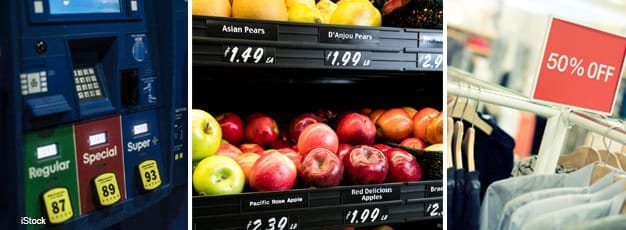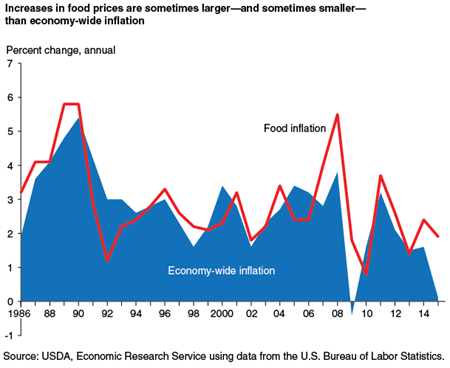Food Price Inflation Has Outpaced Economy-Wide Inflation in Recent Years

The all-items Consumer Price Index (CPI) measures overall price changes across seven major household spending categories: housing, transportation, food, medical care, apparel, education and communication, and recreation. According to the Consumer Expenditure Survey, the average American household allocates 12.6 percent of its expenditures on food, both at home and away from home, making food the third largest expenditure category behind housing and transportation. Typically, food price inflation moves in the same direction as economy-wide inflation, but their magnitudes may vary.
In some of the last 30 years, increases in food prices have outpaced general inflation; in other years, they have not. From 1986 through 1990, food price inflation was higher than economy- wide inflation in 4 out of 5 years. For example, in 1989, food prices rose 5.8 percent over 1988 price levels due to large increases in prices of meats, eggs, and fresh fruit and vegetables. Economy-wide inflation was 4.8 percent that year.
However, throughout much of the 1990s and early 2000s, food price inflation was lower than economy-wide inflation, including 5 consecutive years from 1991 to 1995. Rising prices for medical care and housing helped push up the all-items CPI during those years. Annual price increases for these two categories in 1991-95 ranged from 4.5 to 8.7 percent for medical care and from 2.5 to 4.0 percent for housing.
More recently, food price inflation has outpaced economy-wide inflation in 7 of the last 9 years. While economy-wide inflation rose 2.8 percent in 2007 and 3.8 percent in 2008, food prices rose 4.0 percent in 2007 and 5.5 percent in 2008 due to a rapid increase in farm-level prices for rice, grains, and oilseeds. Through their impact on income and employment, the 2007-09 recession and its aftermath put downward pressure on prices of many goods and services, including food, which rose 1.8 percent in 2009 and 0.8 percent in 2010. However, the all-items CPI fell by 0.4 percent in 2009 and rose only 1.6 percent in 2010.
In 2015, food prices increased 1.9 percent, a smaller rise than the 2.4-percent increase in 2014. Declining prices for pork, dairy, fats and oils, and fresh fruit helped ease food price inflation. Economy-wide inflation measured 0.1 percent in 2015, in large part due to a 7.8-percent decrease in transportation prices as a result of lower oil prices.
Food Price Outlook, by Matthew MacLachlan and Megan Sweitzer, USDA, Economic Research Service, March 2024


